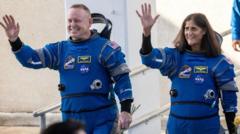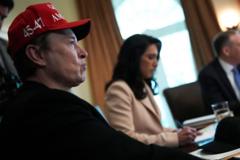The ongoing advancements in robotic technology and artificial intelligence are raising questions about the necessity of human astronauts in space missions. For instance, NASA's Parker Solar Probe recently completed a significant flyby of the Sun without any human oversight, marking a pivotal achievement for autonomous spacecraft. The success of such missions suggests a potential shift toward reliance on robotics for exploring the cosmos.
Can AI-Powered Robots Outperform Human Astronauts in Space Exploration?

Can AI-Powered Robots Outperform Human Astronauts in Space Exploration?
As NASA's Parker Solar Probe embarks on groundbreaking missions autonomously, experts debate the future role of humans in space travel.
Throughout the history of space exploration, robotic probes have ventured to areas of the solar system that are inaccessible to humans. During its journey, the Parker Solar Probe faced extreme temperatures of 1000 °C, successfully collecting valuable atmospheric data without direct communication with Earth. This has sparked discussions among scientists regarding the diminishing need for manned missions. Lord Martin Rees, the UK's Astronomer Royal, argues that the case for sending humans into space weakens as robots evolve. He believes that taxpayer money should not be allocated for human space exploration and that such ventures should be reserved for private funding.
Andrew Coates, a physicist at University College London, echoes these sentiments, favoring robotic exploration for its affordability and capacity to conduct long-distance science missions. However, the emotional and historical significance of human presence in space remains undeniable. Over 700 people have ventured into Earth’s orbit and the Moon, contributing not only to scientific knowledge but also to the inspiration of future generations.
While robots have successfully explored every planet and numerous asteroids, human missions have been limited to Earth’s orbit and the Moon. Yet, as Dr. Kelly Weinersmith emphasizes, the sense of adventure and prestige associated with human space travel continues to hold value. Despite advances in AI, the notion persists that humans bring unique skills to missions that robots cannot replicate.
As AI technologies evolve, they may assist astronauts by handling mundane tasks to enhance mission efficacy. However, logistical challenges remain, as current technology like large language models requires significant computing power that is not feasible on devices currently used in space exploration, such as Mars rovers.
NASA’s efforts to develop humanoid robots like Valkyrie showcase the potential to create machines capable of performing intricate tasks alongside human astronauts. These robots may not entirely replace humans but rather augment their work in extreme environments. NASA's Curiosity rover exemplifies autonomous exploration, executing scientific tasks independently, yet the speed and decision-making abilities of human astronauts still surpass those of current robotic technologies.
The ultimate question remains: can robots inspire humanity in the same way as human astronauts do? Leroy Chiao, a retired NASA astronaut, believes that human achievements remain central to public engagement in space exploration. As discussions surrounding manned missions persist, NASA aims to land humans on the Moon via its Artemis program, while private sectors like SpaceX look to propel civilizations on Mars.
As we contemplate the future of space exploration, the possibility of merging human and robotic capabilities might pave the way for sustainable and groundbreaking ventures into the cosmos. With ethical dilemmas and challenges on the horizon, the journey to explore beyond our planet continues—one small step for humans and one giant leap for robotic technology.
Andrew Coates, a physicist at University College London, echoes these sentiments, favoring robotic exploration for its affordability and capacity to conduct long-distance science missions. However, the emotional and historical significance of human presence in space remains undeniable. Over 700 people have ventured into Earth’s orbit and the Moon, contributing not only to scientific knowledge but also to the inspiration of future generations.
While robots have successfully explored every planet and numerous asteroids, human missions have been limited to Earth’s orbit and the Moon. Yet, as Dr. Kelly Weinersmith emphasizes, the sense of adventure and prestige associated with human space travel continues to hold value. Despite advances in AI, the notion persists that humans bring unique skills to missions that robots cannot replicate.
As AI technologies evolve, they may assist astronauts by handling mundane tasks to enhance mission efficacy. However, logistical challenges remain, as current technology like large language models requires significant computing power that is not feasible on devices currently used in space exploration, such as Mars rovers.
NASA’s efforts to develop humanoid robots like Valkyrie showcase the potential to create machines capable of performing intricate tasks alongside human astronauts. These robots may not entirely replace humans but rather augment their work in extreme environments. NASA's Curiosity rover exemplifies autonomous exploration, executing scientific tasks independently, yet the speed and decision-making abilities of human astronauts still surpass those of current robotic technologies.
The ultimate question remains: can robots inspire humanity in the same way as human astronauts do? Leroy Chiao, a retired NASA astronaut, believes that human achievements remain central to public engagement in space exploration. As discussions surrounding manned missions persist, NASA aims to land humans on the Moon via its Artemis program, while private sectors like SpaceX look to propel civilizations on Mars.
As we contemplate the future of space exploration, the possibility of merging human and robotic capabilities might pave the way for sustainable and groundbreaking ventures into the cosmos. With ethical dilemmas and challenges on the horizon, the journey to explore beyond our planet continues—one small step for humans and one giant leap for robotic technology.


















